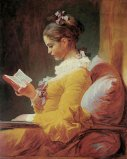 Writers love to read. Their love of words is often
one of the reasons they become writers. They love falling into the fictional
dream, immersing themselves in the lives of characters and wondering how the
plot will turn out.
Often what they love to read is what they love to
write as well. I don’t think I could write a book I would hate reading. I just
wouldn’t be passionate about it.
For example, I enjoy reading historical romance.
That’s also what I enjoy writing and can’t really picture myself writing in any
other genre. I love learning about by-gone eras and different ways of life, adding
characters and plots into the mix. Those who write Contemporary, Speculative,
Young Adult, and all other genres, I’m sure feel the same.
Writers love to read. Their love of words is often
one of the reasons they become writers. They love falling into the fictional
dream, immersing themselves in the lives of characters and wondering how the
plot will turn out.
Often what they love to read is what they love to
write as well. I don’t think I could write a book I would hate reading. I just
wouldn’t be passionate about it.
For example, I enjoy reading historical romance.
That’s also what I enjoy writing and can’t really picture myself writing in any
other genre. I love learning about by-gone eras and different ways of life, adding
characters and plots into the mix. Those who write Contemporary, Speculative,
Young Adult, and all other genres, I’m sure feel the same.
Yet should writers only read what they write?
No. Although probably at least 80% of the novels I
read are historical romance, if an author reads only in the genre they write
in, their work has a tendency to stagnate. Without a broad spectrum of genres,
styles, etc., an author might find their work tending towards cliché. When I
read something different than the norm for me, it provides a different
perspective on writing in general. Style, after all, is style, no matter what
the genre.
For example, I might read a couple of historical
romances, then switch to a classic, then perhaps read something research
related, such as a biography.
TIPS
Here are a couple of tips to expand your reading repertoire.
1
– Check bestseller lists – Although, as many of you will
agree, not all novels that make it to the bestseller lists deserve to be there,
many of them are extremely well-written. While reading these analyze what made
the novel so popular. What worked for you and what didn’t? There are always novels
that are making the rounds and it seems everywhere they are being talked about.
For example, The Help, or The Hunger Games, both of which have
been quite popular as of late. I’m not implying reading everything that hits the
bestseller lists, however, choose a few novels that you might not ordinarily
pick up. You will find this can boost your own writing.
2
– Read the classics – Although I tend to gravitate towards the
newer novels, when I want a quick easy read there is so much depth and value in
classics, that I try to read one every month or so. Recently, I finished Edith
Wharton’s The House of Mirth and
loved it! Although not all the fiction techniques that she used may be
permissible in today’s market, such as the long descriptions and chapter upon
chapter of monologue, I’ve never read a classic and not gleaned something that
helped me in my own writing.
3 – Try a new author – Recently, I’ve
been trying several new historical authors and although not everything has been
to my taste, I’ve enjoyed analyzing different styles and plots. Sometimes, when
I’m looking for something new to put on my TBR pile, I just do an Amazon
search, such as “Regency Historical Romance” and see what new authors this
turns up.
Reading is one of the best ways, in fact the best way, in my opinion, to learn
about writing. I always try to have at least one book on hand. I’ve found that
when I don’t read, my writing tends not to have the same quality it does when
I’m reading a good piece of fiction. It’s also a great way to come up with
story and plot ideas.
So what are you waiting for? Read a book, or two, or
twenty! Your readers will thank you!
Happy Writing and Reading,
Amanda
Your
Turn – Let’s talk books. What have you been reading lately that you’ve enjoyed?
Do you tend to read only what you write or do you like to switch it up?





